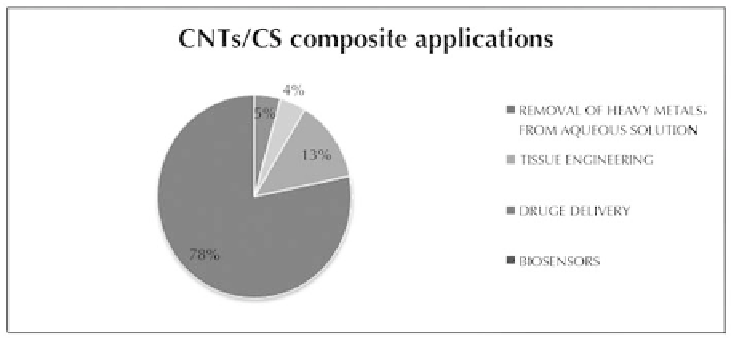Chemistry Reference
In-Depth Information
ied by many groups. Results suggested the possible creation of photovoltaic devices
due to hole-collecting electrode of CNTs [117].
Food packaging is another remarkable application of CNT composites. Usually,
poor mechanical and barrier properties have limited applying biopolymers. Hence,
appropriate fi ller is necessary for promotion of matrix properties. Unique properties
of CNTs has been improved thermal stability, strength and modulus, and better water
vapor transmission rate of applied composites in this industrial [118].
CHITOSAN/CARBON NANOTUBE COMPOSITES
In recent decade, scientists interested to creation of CS/CNTs composite due to provid-
ing unexampled properties of this composite. They attempted to create new properties
by adding the CNTs to CS biopolymers. At recent years, several research articles were
published in variety of applications. Figure 7.6 summarizes the application of CS/
CNTs nanocomposies.
Figure 7.6.
The graph of CNTs/CS nanocomposite application.
Chitosan/Carbon Nanotube Nanofluids
Viscosity and thermal conductivity of nanofluids containing MWNTs stabilized by CS
were investigated by Phuoc et al. [119]. It has been shown that thermal conductivity
enhances significantly higher than the predicted amount using the Maxwell's theory.
In addition, they observed that dispersing CS into deionized water increased the vis-
cosity of nanofluids significantly and its behavior switches to non-Newtonian fluid.
Preparation Methods of CNTs/CS Nanocomposites
There are several methods for creation of nano-biocomposites. Among them, research-
ers have studied some of these methods for preparation of the CNTs/CS nanocomposites.
Solution-casting-evaporation
Electrochemical sensing of CNT/CS in a media containing dehydrogenase enzymes
for preparing glucose biosensor initially investigated in 2004 [120]. The nanotube

















Search WWH ::

Custom Search